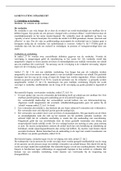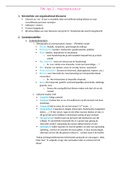Most common cause of acute bleed lower G.I:
Small bleed: hemorrhoids and fissures and polyps
Massive bleeds: diverticula, ischemic colitis
Most common cause of chronic bleed G.I: hookworm
Gastric cancer and peptic ulcer: epigastric pain (patient points 1 finger)
Small intestine is relatively resistant to neoplasms
G.I cancers --> iron deficiency anemia
Zymogens in pancreas serous cell acini: inactivate trypsinogen and chymotripsynogen
Bleeding ulcer treatment: adrenaline, thermalcoag/clips/radiologic coiling/surgica
Most common cancers oesophagus:
Adenocarcinoma: lower 1/3 oes. --> possibly by barrett's oesophgatisi
o Barret's oesophagys: metaplasia; esp obese men; 0,5% cancer risk per year
SSC: middle and upper 1/3 oes. --> possibly by achalasia (dysfunctioning myenteric plexus =
aperistalsis and megaesophagus by failure relaxation LOS)
Most common causes:
Acute pancreatitis: gallstones (60%) -> alcohol (20%)
o Diagnosis: abdominal pain epigastric to back and amylase/lipase 3x normal
o Imaging only if needed to confirm; US to exclude billiary, CT to exclude complications
and confirm diag, MRI if recurrent or negative US in biliary suspection
o Mild =80%, sever =20% -> necrotizing, mortality 20%
o Infected necrosis --> surgical drainage
Chronic pancreatitis: alcohol --> calcifications on x-ray
Complications chronic pancreatitis: pancreatic pseudocysts, ascites, pleural effusion, DM, CF
Gastritis: H. pylori; also possibly irritants (most comonly aspirin and alcohol!!), trauma etc.
o Increased permeability of gastric barries (mucosa and tight junctions) --> higher risk
of peptic ulcer
Peptic ulcer causes: H. pylori, smoking, alcohol (damages mucosa), NSAID/aspirin
H.Pylori: below mucosa attaches to epithelium + urease = urea to NH3 basic and Cl- which are
both cytotoxic to the small intestine and NH3 stimulates secretion of HCL
Peppermint, chocolate, coffee, licorice, fat, alcohol --> relax the LOS --> pyrosis/heartburn in
GORD
Positive H. pylori test:
o <55 yrs: triple therapy
o >55 yrs, first endoscopy to exclude malignant cause
Surgery G.I:
Chronic pancreatitis and pancreatic carcinoma: severe knagende pijn, relieved by leaning
forwads
IBS: alternating diarrhea and constipation, bloating pain esp. After meal
Most common cause of nonacute abdominal pain in children: infantile colitits (cow milk
allergy for example), IBS, IBD, streptococcus
Most common diagnosis of diarrhea after intestinal infection is IBS
Pseudomembranous colitis - diarrhea by C. difficile
, Dark blood in stool = transverse, descending colon; in from proximal G.I, usually blood
altered by digestion --> melaena
Mucus w/ stool mostly with IBS
Tenesmus mostly with IBS or rectal/anal tumor
Courvousier's law: If obstructive jaundice and distended gallbladder --> probably tumor not
gallstones bc stones = chronic inflammation = fibrosis = prevents distension
US is first choice biliary investigation but low reliability distal bilde duct
Strictures most commonly by post-operative fibrosis or inflammation (cholecystitis = mirizzi
syndrome)
Treatment of obstructive noncurable tumor = stenting palliatively
Right iliac fossa = common site asymptomatic mass
Crohns disease of terminal ileum can present as tender mass , with pain and diarrhea
Primary liver tumors only common in developing countries; by hepatitis B and C
Pancreatic cancer:
o 90% adenocarcinoma of exocrine ductal cells ; most detected at incurable stage
o Worst prognosis of all G.I cancers ; but well differentiated ductual
o Risk factors: smoking, chronic pancreatitis, obesity, DM11, family
o Obstructive jaundice: pale stool and dark urine, conjugated
Jaundice by panc and other obstructive tumor are usually painless, while
gallstone obstructive jaundice has pain
o Golden standard: EUS to assess tumor size, site, vascular involvement, potential
operability
o Curable cancers --> surgical = Whipple operation - pancreaticoduodenectomy
High mortality and morbidity
o Palliative: stent obstructive jaundice, pain treatment with coeliac ganglion blockade
HCC and cholangiocarcinome, unlike pancreatic cancer slow growing and late metastases
Gallbladder carcinoma
o Old age
o Associated with gallstones
o Carcinogenic factor = chronic inflammation
Liver abcess most commonly by amoeba
HCC causes: hepatitis B and C, chronic hepatitis, hemochromatosis, alcoholic
o By diagnosis time, usually spread in liver so low chance curative
Resecting metastatic cancer usually not useful but with colorectal cancer spreading to the
liver it is useful
GORD kan via aspiratie pneumonie astma verergeren
Anatomy:
Spleen: emryonic derivative = mesoderm
Celiac trunk = foregut--> oes. To 1/2 duodenum
SMA = midgut --> distal 1/2 duod to 2/3 transverse colon
IMA = hindgut --> distal 1/3 transverse colon to anal canal
Liver: Bile canaliculi --> Canals of Hering (w/ cholangiocytes of cuboidal epithelium) --> bile
ductules --> bile ducts in portal triad --> L & R hepatic duct --> common hepatic duct
LIVER
Na maaltijd: insuline zorgt voor lipogenese: A.A naar ketonzuren --> v.z --> triglyceriden
Vasten: glucagon zorgt voor afbraak eiwit, glycogeen en vet: triglyceriden naar v.z naar
ketonzuren; glycogeen naar pyruvic acid en lactic acid
o Lipolyse: B oxidatie = vetzuren omgezet in acetylcoA voor krebs cyclus












